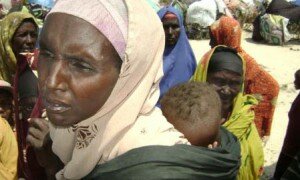SOMALIA: Heavy rains aggravating conditions for “poorest of the poorâ€
 NAIROBI, 14 May 2009 (IRIN) – Heavy rains have compounded the already difficult conditions for thousands of internally displaced persons (IDPs), who fled fighting in Mogadishu for camps outside the Somali capital, civil society groups said.
NAIROBI, 14 May 2009 (IRIN) – Heavy rains have compounded the already difficult conditions for thousands of internally displaced persons (IDPs), who fled fighting in Mogadishu for camps outside the Somali capital, civil society groups said.
“The rains have made their living conditions even more difficult; almost all the new arrivals are staying under trees with nothing to shelter from the rains,†Ahmed Dini of Peaceline, a Somali civil society group, who was visiting the IDPs at the Ceelsha camps (15km south of Mogadishu), told IRIN on 14 May.
He said many of those displaced by the latest fighting were first-time IDPs, residents of some of the poorest neighbourhoods of Mogadishu.
“These are people from the Siina’a, Arjantiina and Tookiyo [all slums in the north of the city]; they are the poorest of the poor,” Dini said.
He said they had stayed put during previous clashes in the capital because they did not have the means to escape.
“It is an indication of how bad things are,” he said. “This current displacement is affecting mainly minorities and others who have no clan support.”
Dini said the civil society community was appealing to Somalis and donor agencies, “particularly to the United Nations, to urgently come to the assistance of these people who are living in the open and under trees”.
 Photo: Hassan Mahamud Ahmed/IRIN |
| Some of those displaced by the latest fighting are living under trees on the oukskirts of the city – file photo |
Nadiifo Hussein, one of the displaced, fled her home in the Siina’a slum on 13 May following heavy fighting and shelling. She went to the Ceelsha camps where she is caring for eight orphaned relatives.
“I left my house with nothing except what I am wearing and these children,” said Hussein.
She said they had taken advantage of a lull in the fighting to escape but she was worried about how she would feed the children. “I had a small stall in the market and that was our food; now I don’t know what I will give them.”
Dini, whose group monitors children, said 60 of the 150 dead and 125 of the more than 300 injured were children.
Daily exodus
Despite a lull in fighting on 13 May, many people were still leaving the city.
The UN Refugee Agency (UNHCR) said the rate of displacement was increasing on a daily basis.
“Between yesterday [13 May] and the day before, 10,000 people were displaced,” said Roberta Russo, spokeswoman for UNHCR Somalia.
Russo said the agency had partners on the ground who were preparing for the immediate distribution of shelter material and sleeping mats, blankets and kitchen sets.
“In the warehouse in Mogadishu, we already have sets for over 100,000 people,” she said. “We are also planning to appeal to all parties through radio and other mass media to spare civilians.”
 Photo: ReliefWeb |
Renewed fighting
Meanwhile, the fighting in Mogadishu resumed on 14 May in the northern part of the city, according to a local journalist who requested anonymity.
“There are clashes going on at Afarta Jardiino [north Mogadishu],” he said. “It is not as bad as it was three days ago but it is forcing people out of the area,” he added.
The UN Special Representative for Somalia, Ahmedou Ould-Abdallah, has accused those who launched the recent attacks on Mogadishu of carrying out “an attempted coup d’état to topple a legitimate government using force.
“These extremists know that they do not have the support of the Somali people and that is why they have to bring in foreign fighters who are not connected to the situation in Somalia in any way,” Ould-Abdallah said.
Forces loyal to the Government of National Unity are fighting an alliance of the militant al-Shabab group and elements of the Hisbul Islam alliance.
Comments
comments
 Calendar
Calendar






































